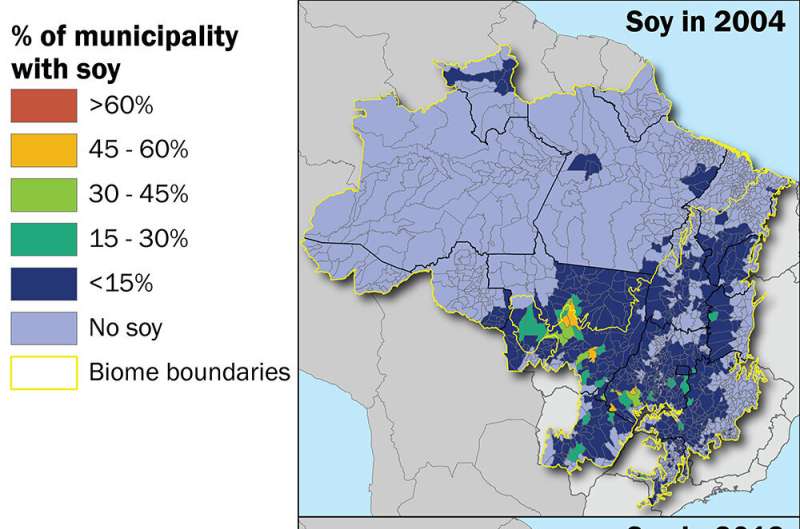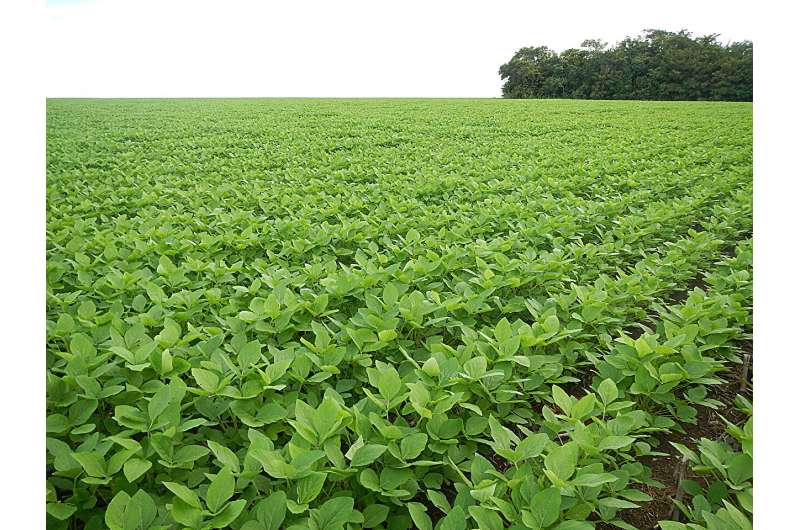Soy expansion in Brazil linked to increase in childhood leukemia deaths

Over the past decades, Brazil has become the world’s leading soybean producer, as well as the leading consumer of pesticides. Despite concerns about potential public health consequences, little is known about the effects of pesticide exposure in the general population.
A new study from the University of Illinois Urbana-Champaign in collaboration with the University of Denver and University of Wisconsin-Madison looks at how soy expansion and increased pesticide use in Brazil’s Cerrado and Amazon biomes correlate with increased childhood cancer mortality.
“The Brazilian Amazon region is undergoing a transition from low-input cattle production to intensified soy culture with high use of pesticides and herbicides. The expansion has happened really quickly, and it appears educational efforts and training for pesticide applicators didn’t match the growth in pesticide use. When not used properly, there are health implications,” said Marin Skidmore, assistant professor in the Department of Agricultural and Consumer Economics, part of the College of Agricultural, Consumer and Environmental Sciences (ACES) at U. of I.
Skidmore is lead author on the paper, published in Proceedings of the National Academy of Sciences(PNAS).
“As this transition was happening, there were documented cases of pesticide poisoning of agricultural workers and evidence of chemicals in the blood and urine samples of non-agricultural workers in the surrounding communities,” Skidmore said. “This indicates that this rollout had happened in a potentially dangerous way that was leaving people exposed.”
The researchers investigated public health consequences of exposure to pesticides, focusing on children as the most vulnerable population. They specifically looked at deaths from acute lymphoblastic leukemia (ALL), the most common childhood bloodborne cancer.
Their study drew from data on health outcomes, land use, surface water, and demographics in the Amazon and Cerrado biomes. The sample primarily consisted of areas that are classified as “rural” and have at least 25% of land cover in agriculture.
Soy production in the Cerrado area tripled from 2000 to 2019, and in the Amazon region there was a 20-fold increase, from 0.25 to 5 million hectares. Pesticide use in the study region increased between three- and 10-fold during the period as well. Brazilian soy farmers apply pesticides at a rate 2.3 times higher per hectare than the United States.
“Our results show a significant relationship between Brazil’s soy expansion and childhood deaths from ALL in the region,” Skidmore said. “Results suggest that about half of pediatric leukemia deaths over a 10-year period may be linked to agricultural intensification and exposure to pesticides.”
Skidmore and her colleagues show that a 10-percentage point increase in soy production is associated with an additional 0.40 deaths from ALL of children under five and an additional 0.21 deaths under 10 per 10,000 population. In total, they estimate that 123 children under 10 died from ALL associated with pesticide exposure between 2008 and 2019, out of a total of 226 reported deaths from ALL in the same period.
Skidmore emphasized that the study doesn’t provide a direct, causal link between pesticide exposure and cancer deaths, but the researchers take a number of steps to rule out other potential explanations. They found no correlations between ALL deaths and soy consumption, changes in socioeconomic status, or prevalence of crops with lower rates of pesticide applications.

The researchers also investigated contamination of water sources as a primary method of pesticide exposure.
“We looked for evidence of pesticide application upstream, in the watershed that flows into a region, and we found it is related to leukemia outcomes in the downstream region. This indicates that pesticide runoff into surface water is a likely method of exposure,” Skidmore explained.
“About 50% of the rural households in this region had a well or cistern at the time of the 2006 agricultural census, which left the other 50% reliant on surface water as a source of drinking water. If the surface water is contaminated, pesticides used in soy production upstream can reach children living downstream through waterways.”
“Our concern is that our results are only the tip of the iceberg. We measured one small, very precise outcome. Pesticide exposure may also result in non-fatal cases of leukemia, and there is a risk of impacts on the adult and teenage community,” she said.
ALL is a highly treatable disease, but it requires access to quality medical care. In the entire Amazon region, the researchers identified only two high-complexity pediatric oncology centers, although other facilities can also provide treatment. They found that the increase in observed pediatric ALL deaths following soy expansion was limited to municipalities that were more than 100 kilometers from a treatment center.
“Our results indicate that there are several ways to mitigate the relationship between pesticide exposure and ALL deaths,” Skidmore said. “This includes training and education for agricultural workers, smart regulations for pesticide use, and access to health care. We certainly are not advocating for a wholesale stop of using these inputs. They are important and valuable technologies, but they need to be handled safely and with some checks in place.”
Brazil is currently developing a certification program that requires pesticide applicators to undergo safety training and education. Such programs exist in many countries, including the United States, where pesticide applicators are required to be licensed and participate in an annual pesticide safety education and testing program.
“I think there is a strong awareness that safe use of pesticides is what’s best both for agricultural productivity and for the communities. This soy expansion and boom are in many ways a huge win for Brazil’s economy,” Skidmore stated.
“We want to highlight that when changes happen fast, there are risks associated with that, and this is not isolated to Brazil. There is a lot of focus on agricultural intensification for global food security around the world. We need to find a balance where we get the productive benefits while mitigating any potential risks.”
“When there is rapid rollout of these technologies in a new region, often an underdeveloped or poor region, how do we ensure there are guardrails in place to prevent another case like this?”
More information:
Marin Skidmore et al, Agricultural intensification and public health: Evidence from Brazilian soy expansion, Proceedings of the National Academy of Sciences (2023).
Journal information:
Proceedings of the National Academy of Sciences
Source: Read Full Article
